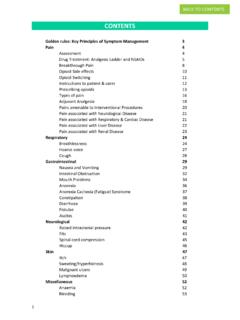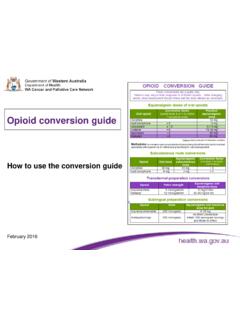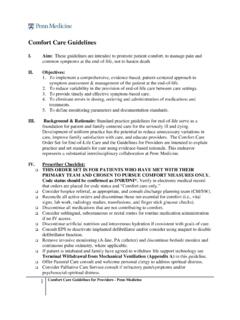Transcription of Guidance for the use of opioids with renal impairment
1 Guidance on the use of opioids in renal impairment in palliative care opioid use in renal impairment can lead to an increase in opioid toxicity and therefore may lead to an increase in symptom burden. When using opioids at the end of life concerns have been expressed that opioid toxicity could also mimic the dying process1. As clinicians, we thus have a role to understand the potential risks of the medications we use and minimise their side-effects. renal function is increasingly classified according to criteria for chronic kidney disease (CKD). This classification uses estimated glomerular filtration rate (eGFR). CKD category eGFR Terms CKD1 >90 ml/min normal or high CKD2 60-89 ml/min mild reduction CKD3a 45-59 ml/min mild-moderate reduction CKD3b 30-44 ml/min moderate-severe reduction CKD4 15-29 ml/min severe reduction CKD5 <15 ml/min kidney failure Estimation of kidney function in critically ill patients with acute kidney injury (AKI), is important for appropriate dosing of drugs and adjustment of therapeutic strategies, but challenging due to fluctuations in kidney function, creatinine metabolism and fluid balance.
2 Data on the agreement between estimating and gold standard methods to assess glomerular filtration rate (GFR) in early AKI are lacking. Morphine is now and will remain the 1st line strong opioid for pain control with individuals with normal renal function. Mild to moderate reduction eGFR 30-89 ml/min The presence of renal impairment is not a reason to delay the use of opioids in cancer pain management. All opioids that are used for cancer related pain can be used in this population; however there may be a requirement to reduce the dose and frequency of the opioid . Be aware that estimates of GFR are less accurate in the presence of low protein states, cachexia, oedema, and acute renal failure.
3 An estimated GFR at the lower end of the moderate range should therefore prompt consideration of a change in opioids to one considered safer in renal impairment in these clinical settings. Monitoring for change in renal function is often appropriate; consider a pre-emptive change of opioids in rapidly deteriorating renal function. Assess for any reversible factors medication (diuretics, NSAIDs), dehydration, obstructive uropathy. Severe reduction and kidney failure eGFR <30ml/min 1st line Fentanyl transdermal fentanyl may be appropriate if pain is stable and patient not in the last days of life, can take up to 2 days to reach steady state not to be used in opioid na ve patients be aware of the wide range in morphine equivalence 24 hourly morphine dose (mg) Fentanyl patch strength (mcg/hr) with eGFR 15-30 Oxynorm prn dose (mg) ( 25-50% of normal dose )
4 Every 6-8 hours 45 12 <90 25 90-134 37 135-189 50 190-224 62 225-314 75 PRN dose Oral opioid prns and their metabolites can all accumulate in severe renal impairment and therefore there is a risk of opioid toxicity, thus clinical monitoring for toxicity and effectiveness is vital. Avoid morphine/diamorphine. Oxynorm MAY be safer but do not use regularly and the prn dose needs to be lower. 50% of normal dose in severe renal impairment . There may be a role for buccal/sublingual fentanyl for prn opioids Effentora, however this still needs to be titrated from 100mcg despite regular opioid dose. If needing syringe driver: Alfentanil Used subcutaneously, as potent as sc fentanyl but is beneficial because of ability to use high volumes in syringe driver Be aware of the wide variability in the conversion of alfentanil* Alfentanil has a shorter duration of analgesia, thus concerns exist about its use as a prn in the community where nursing is not so available In this context PRN Oxycodone MAY be appropriate in the end of life setting, toxicity potential may be reduced if only used as a prn medication, with a lower dose and extended frequency than normally advised.
5 Diamorphine sc dose (mg over 24 hrs) Alfentanil sc dose (mg over 24hrs) Alfentanil sc prn dose (mg) Oxycodone sc dose 6 hourly (mg) 10mg 1mg 20mg 2mg 30mg 3mg * Potency ratio of diamorphine:alfentanil varies from 1:10 to 1:6. Always use the more conservative ratio when rotating: if going from diamorphine to alfentanil use ratio of 1:10, so 10mg diamorphine = 1mg alfentanil; however, if going from alfentanil to diamorphine use 1:6, so 1mg alfentanil = 6mg diamorphine. Tramadol Use with care 50mg 12hourly Tapentadol Use with care in severe and end stage renal failure Probably safe in mild to moderate renal impairment Modified release 50mg bd and titrate carefully if appropriate Tapentadol 50mg IR also available For more details about the pharmacokinetics of opioids in renal failure and a systematic review of the use of opioid medication in renal impairment see: King S et al.
6 palliative Medicine 25(5): 525-552. Reference 1. King S, Forbes K, Hanks GW, Ferro CJ, Chambers EJ. A Systematic review of the use of opioid medication for those with moderate to severe cancer pain and renal impairment : A European palliative Care Research Collaborative opioid Guidelines Project. palliative Medicine 2011; 25(5): 525-552. 2. Guidelines for LCP drug prescribing in advanced chronic kidney disease. 3. Clinical guidelines for the use of palliative care drugs in renal failure. Yorkshire palliative Medicine Guidelines Group, 2006. Doug Hooper, palliative Medicine Consultant, St Luke s Hospice Plymouth Review June 2019



